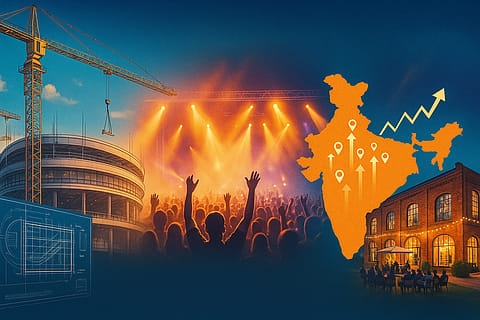India can become a global live entertainment hub with 25–30 new venues: WAVES whitepaper
The paper identifies that there is a significant dearth of mid-size venues (with capacities of 2,000 to 10,000) in the country.

To be counted among the top five global destinations for live entertainment by 2030, India must increase its number of purpose-built concert venues from fewer than 10 to at least 25–30. This was highlighted in a recent whitepaper on India’s live entertainment economy, released on the sidelines of the inaugural WAVES summit in Mumbai. The whitepaper titled ‘Experience India’ by Eventfaqs Media revealed that for now, the country must prioritise building world-class venues across metro and Tier-2 cities and creating a single-window licensing framework for ease of event execution.
In 2024, India’s organised live events sector grew by 15%, adding an estimated ₹13 billion in revenue. Despite this surge, the country has just over 10 concert venues with a capacity of 10,000 or more—mostly concentrated in metro cities—with virtually no such infrastructure in Tier 2 markets.
The paper identifies that there is a significant dearth of mid-size venues (with capacities of 2,000 to 10,000) in the country. These are vital for scalable experiences that don’t require a stadium-level setup. This "middle layer" is crucial to support touring IPs, regional artist performances, experimental formats such as immersive theatre, and genre-specific events like hip-hop or folk festivals. They also serve as ideal environments for brand activations and D2C showcases.
To be effective, these venues must be designed with built-in acoustics, flexible rigging systems, crowd management features, digital ticketing, backstage amenities, and weather-resilient structures. Such investments will lower execution costs, reduce reliance on expensive outdoor builds, and stabilise the live events calendar.
“Countries that have emerged as live entertainment powerhouses have invested in multi-use, high-capacity, and strategically located venues that serve as cultural landmarks and economic drivers, (such as O2 Arena, London (UK), Coca-Cola Arena, Dubai (UAE), and Marina Bay Sands & Gardens by the Bay, Singapore),” the paper said.
Developing idle urban infrastructure as cultural districts
India’s cities host large swathes of idle urban infrastructure — including mills, docks, rail yards, and factories — that could be reimagined as cultural districts, similar to Melbourne’s Docklands or Dubai’s Al Quoz Creative Zone. The paper recommends that state-led mapping of redevelopment-eligible zones, long-term leases or joint ventures with developers that have a cultural mandate, and incentivising mixed-use precincts with food, retail, and event offerings, can help in building these districts much faster.
Recommended Stories
Fast-tracking licensing and offering GST rebates can encourage investment in the live entertainment economy
The whitepaper also emphasised that for India to unlock its full potential in live entertainment, the focus must go beyond infrastructure. A national skilling and safety certification programme is critical to professionalise the industry. Equally vital is the creation of a centralised music licensing portal to ensure compliance and transparency across the board. Funding should also flow into homegrown intellectual properties (IPs) and regional artist ecosystems to nurture local talent and content.
At present, organising a live event in India is no small feat — securing permissions means navigating 10–15 departments per city, often with unpredictable timelines ranging from a week to over a month. Add to this the steep 18% GST on ticket sales and rentals, local levies, and high infrastructure costs, and this makes clear why investors are wary, especially in non-metro markets.
To ease these burdens, the report recommends GST rebates for cultural infrastructure under existing infrastructure or MSME schemes, 10-year tax holidays or concessional tax rates for mid-size venues in Tier 2 and Tier 3 cities, and subsidised electricity and water tariffs for certified cultural spaces. Additionally, offering rental waivers or viability gap funding for state-owned venues operated by private players could unlock much-needed capital. Together, these measures would not only reduce financial risk but also build long-term confidence in India’s live entertainment economy.
(INR CR)